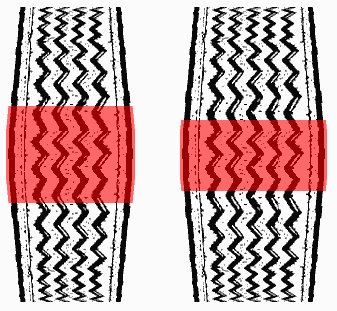Quote:
Originally Posted by manveet  I disagree.
Wider tires will obviously have a greater area of contact. |
Actually not - the tyre bible has a nice example ...
Car Bibles : The Wheel and Tyre Bible
If there's one question guaranteed to promote argument and counter argument, it's this : do wide tyres give me better grip?
Fat tyres look good. In fact they look stonkingly good. In the dry they are mercilessly full of grip. In the wet, you might want to make sure your insurance is paid up, especially if you're in a rear-wheel-drive car. Contrary to what you might think (and to what I used to think), bigger contact patch does not
necessarily mean increased grip. Better yet, fatter tyres do not mean bigger contact patch. Confused? Check it out:
Pressure=weight/area.
That's about as simple a physics equation as you can get. For the general case of most car tyres travelling on a road, it works pretty well. Let me explain. Let's say you've got some regular tyres, as supplied with your car. They're inflated to 30psi and your car weighs 1500Kg. Roughly speaking, each tyre is taking about a quarter of your car's weight - in this case 375Kg. In metric, 30psi is about 2.11Kg/cm².
By that formula, the area of your contact patch is going to be roughly 375 / 2.11 = 177.7cm² (weight divided by pressure)
Let's say your standard tyres are 185/65R14 - a good middle-ground, factory-fit tyre. That means the tread width is 18.5cm side to side. So your contact patch with all these variables is going to be about 177.7cm² / 18.5, which is 9.8cm. Your contact patch is a rectangle 18.5cm across the width of the tyre by 9.8cm front-to-back where it sits 'flat' on the road.
Still with me? Great. You've taken your car to the tyre dealer and with the help of my tyre calculator, figured out that you can get some swanky 225/50R15 tyres. You polish up the 15inch rims, get the tyres fitted and drive off. Let's look at the equation again. The weight of your car bearing down on the wheels hasn't changed. The PSI in the tyres is going to be about the same. If those two variables haven't changed, then your contact patch is still going to be the same : 177.7cm²
However you now have wider tyres - the tread width is now 22.5cm instead of 18.5cm. The same contact patch but with wider tyres means a narrower contact area front-to-back. In this example, it becomes 177.7cm² / 22.5, which is 7.8cm.

Imagine driving on to a glass road and looking up underneath your tyres. This is the example contact patch (in red) for the situation I explained above. The narrower tyre has a longer, thinner contact patch. The fatter tyre has a shorter, wider contact patch, but the area is the same on both. And there is your 'eureka' moment. Overall, the
area of your contact patch has remained more or less the same. But by putting wider tyres on, the
shape of the contact patch has changed. Actually, the contact patch is really a squashed oval rather than a rectangle, but for the sake of simplicity on this site, I've illustrated it as a rectangle - it makes the concept a little easier to understand. So has the penny dropped? I'll assume it has. So now you understand that it makes no difference to the contact patch, this leads us on nicely to the sticky topic of grip.
The
area of the contact patch does not affect the actual grip of the tyre. The things that
do affect grip are the coefficient of friction and the load on the tyre -
tyre load sensitivity.





 Imagine driving on to a glass road and looking up underneath your tyres. This is the example contact patch (in red) for the situation I explained above. The narrower tyre has a longer, thinner contact patch. The fatter tyre has a shorter, wider contact patch, but the area is the same on both. And there is your 'eureka' moment. Overall, the area of your contact patch has remained more or less the same. But by putting wider tyres on, the shape of the contact patch has changed. Actually, the contact patch is really a squashed oval rather than a rectangle, but for the sake of simplicity on this site, I've illustrated it as a rectangle - it makes the concept a little easier to understand. So has the penny dropped? I'll assume it has. So now you understand that it makes no difference to the contact patch, this leads us on nicely to the sticky topic of grip.
Imagine driving on to a glass road and looking up underneath your tyres. This is the example contact patch (in red) for the situation I explained above. The narrower tyre has a longer, thinner contact patch. The fatter tyre has a shorter, wider contact patch, but the area is the same on both. And there is your 'eureka' moment. Overall, the area of your contact patch has remained more or less the same. But by putting wider tyres on, the shape of the contact patch has changed. Actually, the contact patch is really a squashed oval rather than a rectangle, but for the sake of simplicity on this site, I've illustrated it as a rectangle - it makes the concept a little easier to understand. So has the penny dropped? I'll assume it has. So now you understand that it makes no difference to the contact patch, this leads us on nicely to the sticky topic of grip. 
 .
. .. do Accord owners on the forum follow this ?
.. do Accord owners on the forum follow this ?